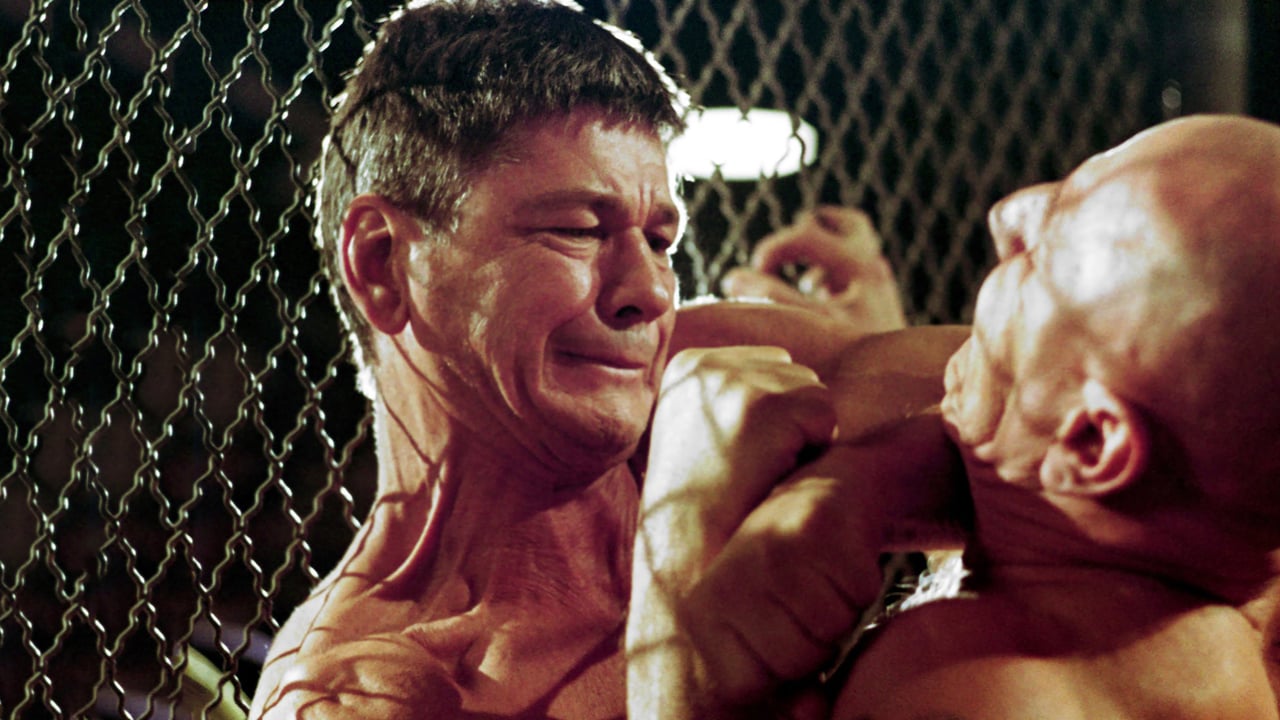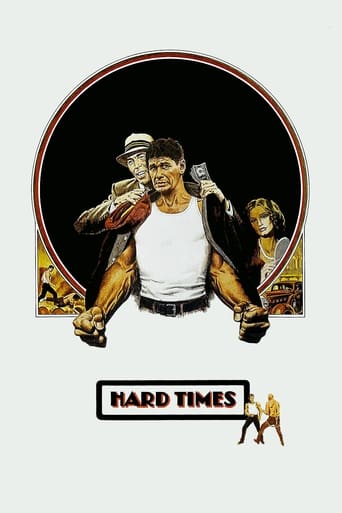

one of my absolute favorites!
... View MoreWatch something else. There are very few redeeming qualities to this film.
... View Moreit is the rare 'crazy' movie that actually has something to say.
... View MoreExcellent and certainly provocative... If nothing else, the film is a real conversation starter.
... View MoreHard Times (1975) **** (out of 4)Criminally underrated gem set in Louisiana during the Depression. A hustler named Speed (James Coburn) strikes gold when he meets bare- fist fighter Chaney (Charles Bronson). The two strike up a business relationship as the loner Chaney tries to woo a lady (Jill Ireland) but it doesn't take long for Speed to run into some crime people that he owes money.HARD TIMES is a pretty unique gem that came out of nowhere and quickly became a modest hit, got some good reviews and remained a favorite to fans of the cast. With that said, Walter Hill's film has never really gotten the credit it deserved because it really is one of the best films of its type and features two terrific performances by the leads. Yes, both leads played this type of characters before and yes there were many films set during the Depression but everything here just rings so fresh and original with the cast really taking their familiar roles and making them seem fresh and new.There are so many things that make this film so memorable but one is the perfect setting and atmosphere created by Hill. You really do feel these characters and the setting that they are trapped in. The Louisiana settings are just perfect to look at and they really become a character themselves as they're so important to building up the other characters. The music score is extremely good, the cinematography perfectly captures everything and there's no question that Hill handles the screenplay without any problems.Then, there's Bronson and Coburn. Both actors were used to playing these type of roles but they go beyond anything they had previously done. Bronson can play quiet perfectly and I think this is something that gets overlooked. It's not easy being quiet and managing to still handle scenes but he does it without a problem. That quiet nature perfectly fits the character and everything you need to know the actor tells you with his eyes. Coburn is fiery, feisty and constantly talking and he does it with ease. The chemistry between the two is terrific. Ireland turns in what is probably her best performance and we get nice support from the likes of Strother Martin, Bruce Glover and Margaret Blye. Why has HARD TIMES been overlooked all these years? Perhaps it's due to Bronson's 80s movies where he became known as an exploitation star. I don't know but the film is certainly one of the best of its type of manages to be a true gem.
... View MoreHard Times is my favorite Charles Bronson film and one of my all time favorite movies. Ideally cast with Bronson as Chaney a mystery man who reveals little of himself while knocking out opponents in bare knuckle brutality, James Coburn co-stars as the cocky and irresponsible Speed who manages Chaney,Strother Martin plays Poe his cut man,and Michael McGuire is a sinister gentleman sportsman who may or may not have been one of the Chicago Black Sox of 1919, and of course Jill Ireland as the world weary Lucy and there is not a false note in any of the performances. Walter Hill's direction is brisk and he keeps the story moving. The cinematography is excellent. You really feel like you are immersed in seedy, dingy Depression era New Orleans.Bronson has fewer then 500 words of dialog but his eyes , his facial expressions, his way of holding his head and his body actions tell his story. Chaney shows up out of nowhere and seems a bit to old to fight bare fisted. He's from the north and he came to make some money is all he will say about himself. Chaney is a role Bronson was born to play.I really am not a boxing fan but Hard Times really pulled me in. It's a great film and tells a wonderful story
... View MoreIt's the Great Depression in New Orleans. Bronson arrives on a freight train with six dollars. Coburn discovers that Bronson has a punch that would penetrate 20 millimeters of steel and they make a lot of cash together participating in pick up fights, sustained only by bets.The fights are brutal. Two shirtless men batter each other until one is insensible. Anything goes in these mano a mano and pata a pata. It's all bare-knuckled fighting, as in a grade-school playground. You can kick an opponent, pull his hair, strangle him, break his back, knee him in the jewels, or ram his head against the wall.Strother Martin is always there as the dope-addicted ex medical student to treat your wounds and bandage you up. But this is Hollywood, not New Orleans in 1935. There's hardly a drop of blood. These guys are real savages, remorseless, and the worst Bronson winds up with is a rather becoming bruise on his temple -- and that only after the climactic fight against the best bare-knuckle fighter in the country, imported, like the gunslinger in "Shane", from elsewhere.If the settings weren't drab enough, with their greenish walls and peeling chintz wallpaper, and the overhead fan that doesn't work, and the spare and spindly furniture, a very portrait of the abandoned railway car I live in, the fights themselves are depressing. As a nation we seem to be turning into a society of cage fighters and air guitar contests. That's for the American man. The American woman can go on afternoon television and sob out her story of sexual abuse as a child. And of course we can all sit back and enjoy American Idol. Man, does our system of values need the services of the failed medical student, Strother Martin. Does he know anything about treating blood poisoning? It isn't the exercise of physical skill that's repulsive. I envy athletes and dancers for being able to do with their bodies things that I could never command mine to do. Jill Ireland, Bronson's whorish sometimes girl friend in the movie, was trained as a ballerina and I admire her for it.It's the objective of the writers and producers that are so repugnant. They're playing to an audience that simply wants to see two behemoths batter each other to the ground. That's the ENTERTAINMENT. It's as if some group of MBAs at Columbia Pictures got together and had a bright idea. Instead of having a story of good and evil with a sprinkling of fist fights, why not make the whole movie about fist fights? The fights themselves follow all the conventions. Bronson's opponents rarely connect. Their round house punches miss by a mile with a great whoosh, while Bronson almost always connects with a sound of braking pottery.If it weren't for that pandering, the movie might be pretty good. Bronson hardly has any lines. He's silent and wears an inscrutable smile. But some of the secondary characters are interesting. Coburn's facial features have never been more mobile. Jill Ireland is appealingly winsome. And there aren't any real villains. The organization that provides Bronson with opponents are men of their word, in a way that Coburn, for instance, isn't. (He recklessly gambles away the debt he owes them.) The period detail has a few anachronisms but is convincing enough, as is the wardrobe. And the ending isn't what the formula demands. Ireland finds another man, more dependable than Bronson, and hooks up with him. And Bronson, who drifted into town in a box car, drifts away into the night.
... View MoreBoth Charles Bronson and Clint Eastwood played during the Seventies bare knuckle prize fighters. But Charles Bronson in Hard Times was infinitely more serious about it whereas Clint's two films Every Which Way But Loose and Any Which Way You Can were played strictly for laughs.Hard Times is set during the Great Depression and in those desperate economic straights people would do just about anything for a little cash. Bronson who grew up in that period actually did do some legitimate prize fighting at one time which is why he looks so natural in the role. With the possible exception of Robert Mitchum, I don't know any other major male film star who came from such a hardscrabble background as Charles Bronson. James Coburn is his co-star and the two veterans from The Magnificent Seven and The Great Escape play beautifully off against each other. Coburn is a gambler/manager. Coburn likes to live life to the fullest and on the edge which exasperates his girl friend Margaret Blye. It's Bronson who approaches Coburn, but it's Coburn with his reckless ways that nearly lands both of them in the toilet with other gamblers and loan sharks. Chief villain of them is Michael McGuire playing Chick Gandil.An interesting choice of name for a villain because Chick Gandil was the ringleader of the infamous Black Sox who threw the 1919 World Series. I did a little research on Gandil and there was no mention of him being involved in the illegal bare knuckle prize fight game. Wikipedia does mention that Gandil did do some boxing before deciding on baseball as a career. At the time of these bare knuckle fights, the real Chick Gandil was involved in some outlaw semi-pro baseball leagues along with other banned players. And he was from California not New Orleans where this film is set. McGuire however is every inch the rogue Gandil was alleged to be.Strother Martin gives a good account of himself as a would be doctor who got thrown out of medical school for opium addiction. As it was called back then, Martin was a hop head. He plays the corner man for Bronson.Hard Times is a nice and occasionally brutal look at how some had to make a living during the Great Depression. A really worthwhile film capturing the era and some of the men who survived it.
... View More